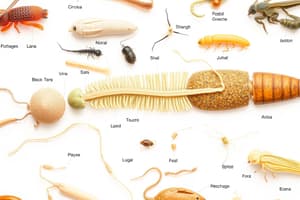Podcast
Questions and Answers
What is the highest taxonomic rank?
What is the highest taxonomic rank?
- Species
- Kingdom
- Domain (correct)
- Phylum
Two species can occupy the same niche in the same habitat.
Two species can occupy the same niche in the same habitat.
False (B)
What is the difference between habitat and niche?
What is the difference between habitat and niche?
Habitat refers to the physical environment where an organism lives, while niche describes the unique role or position of an organism in its environment.
The process of breaking down organic matter by organisms is called _______________________.
The process of breaking down organic matter by organisms is called _______________________.
What type of interaction involves one species capturing and consuming another?
What type of interaction involves one species capturing and consuming another?
Match the following trophic levels with their descriptions:
Match the following trophic levels with their descriptions:
Abiotic factors can affect the distribution and behavior of organisms.
Abiotic factors can affect the distribution and behavior of organisms.
Give an example of an abiotic factor that can affect ecosystem dynamics.
Give an example of an abiotic factor that can affect ecosystem dynamics.
Flashcards are hidden until you start studying
Study Notes
Taxonomy
- Study of the classification, identification, and naming of organisms
- Hierarchical system:
- Domain
- Kingdom
- Phylum
- Class
- Order
- Family
- Genus
- Species
- Taxonomic ranks:
- Species: most specific, unique characteristics
- Genus: grouping of related species
- Family: grouping of related genera
- Order: grouping of related families
- Class: grouping of related orders
- Phylum: grouping of related classes
- Kingdom: grouping of related phyla
- Domain: highest rank, broadest grouping
Habitat Vs Niche
- Habitat:
- Physical environment where an organism lives
- Includes biotic and abiotic factors
- Can be shared by multiple species
- Niche:
- Unique role or position of an organism in its environment
- Includes the organism's habitat, but also its functional role
- Describes how the organism interacts with its environment
- No two species can occupy the same niche in the same habitat
Ecosystem Interactions
- Types of interactions:
- Predation: one species captures and consumes another
- Competition: species compete for same resources
- Mutualism: both species benefit from each other
- Commensalism: one species benefits, the other is unaffected
- Symbiosis: close, long-term relationship between species
- Decomposition: breakdown of organic matter by organisms
- Trophic levels:
- Producers: organisms that produce their own energy (e.g., plants)
- Primary consumers: herbivores, consume producers
- Secondary consumers: carnivores, consume primary consumers
- Tertiary consumers: apex predators, consume secondary consumers
- Decomposers: break down organic matter
Abiotic Factors
- Non-living components of an ecosystem
- Examples:
- Light
- Temperature
- Water
- Soil
- pH
- Oxygen
- Salinity
- Wind
- Topography
- Influence ecosystem dynamics and organism interactions
- Can affect distribution, behavior, and physiology of organisms
Taxonomy
- Study of classification, identification, and naming of organisms
- Hierarchical system consists of: Domain, Kingdom, Phylum, Class, Order, Family, Genus, and Species
- Each taxonomic rank has more specific characteristics:
- Species: most specific, unique characteristics
- Genus: grouping of related species
- Family: grouping of related genera
- Order: grouping of related families
- Class: grouping of related orders
- Phylum: grouping of related classes
- Kingdom: grouping of related phyla
- Domain: highest rank, broadest grouping
Habitat Vs Niche
- Habitat: physical environment where an organism lives, includes biotic and abiotic factors, can be shared by multiple species
- Niche: unique role or position of an organism in its environment, includes habitat and functional role
- No two species can occupy the same niche in the same habitat
Ecosystem Interactions
- Types of interactions:
- Predation: one species captures and consumes another
- Competition: species compete for same resources
- Mutualism: both species benefit from each other
- Commensalism: one species benefits, the other is unaffected
- Symbiosis: close, long-term relationship between species
- Decomposition: breakdown of organic matter by organisms
- Trophic levels:
- Producers: organisms that produce their own energy (e.g., plants)
- Primary consumers: herbivores, consume producers
- Secondary consumers: carnivores, consume primary consumers
- Tertiary consumers: apex predators, consume secondary consumers
- Decomposers: break down organic matter
Abiotic Factors
- Non-living components of an ecosystem
- Examples:
- Light
- Temperature
- Water
- Soil
- pH
- Oxygen
- Salinity
- Wind
- Topography
- Influence ecosystem dynamics and organism interactions
- Affect distribution, behavior, and physiology of organisms
Studying That Suits You
Use AI to generate personalized quizzes and flashcards to suit your learning preferences.




